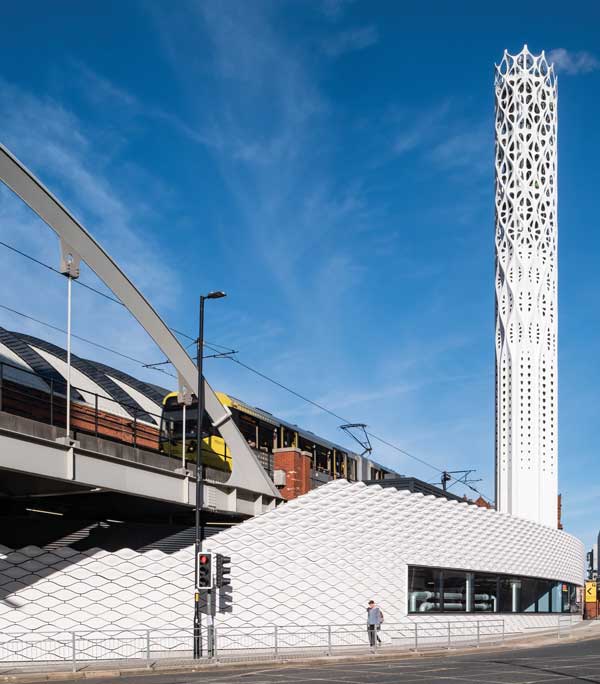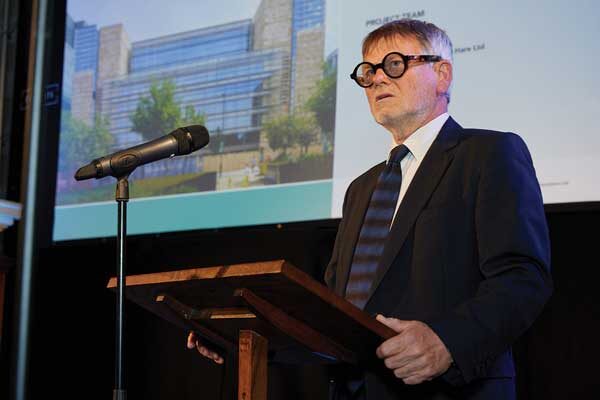SSDA Awards
SSDA 2022: Introduction, Foreword and Judges
Introduction
By Christopher Nash RIBA – Chairman of the Judging panel.
The Panel was this year delighted to be able to return to the usual SSDA judging process no longer constrained by restrictions due to the COVID-19 precautions of the previous two years. Again, this year I was very pleased to moderate the discussions of our talented team of architects, engineering designers and experts from the steel fabrication industry. We were able to meet together face-to-face to examine the schemes submitted and debate their merits. Members of the panel brought their normal enthusiasm and enjoyment to the job, as well as fair-minded professional judgement.
The sponsors and the judges aim for the Awards to be used to showcase excellence in the use of structural steel by practitioners in the UK and Ireland across the full range of sectors, scale, regional location and budget. We are particularly interested in projects that reflect a commitment to reducing lifetime carbon use.
Again, this year there was a wide range of types of projects entered for the scheme. Scales of entry ranged from the largest prestige city office buildings to beautiful footbridges.
As in previous years, we made a preliminary selection on the basis of a ‘desk-top’ examination of the entry documents to create a shortlist. A concise, descriptive and well-presented entry helps to get through the first cut, and those good submissions gave themselves a better chance of selection to the shortlist.
The entrants of resultant shortlisted schemes from the initial selection were all then notified and invited to host a visit by the judges. We pride ourselves in this award scheme on making visits to see, understand and experience all shortlisted projects ‘in the flesh’, and to meet the project teams in person. Our enjoyment of the visits is a large part of why we do it. There is no better way to assess a project than to see it and to hear what it is all about from the team that created it. Projects that are represented by an informed, collaborative and enthusiastic team are a step ahead.
A final summary meeting after all the visits were made required the judges to make a comparative assessment by championing those that each judge visited. We had to consider, compare and assess a great diversity of projects for their architecture and engineering, fabrication and assembly qualities, robustness, innovation and the contribution they make to society at large. These are not easy comparisons to make, and we try to get the balance right.
The awards, commendations, merits and national finalists rewarded by the Structural Steel Design Awards this year reflect the achievements of the current steel construction industry. Everyone involved should be proud of what has been achieved.
Foreword
By Steven Insley, Business Director UK & Ireland, Trimble
Every year, we’re all blown away by the standard of entries received by the Structural Steel Design Awards and 2022 has been no different.
The scale, scope and complexity of the projects submitted are a great example of what can be achieved through digitalisation in the structural steelwork industry, enabling the design, detail, manufacture, and construction of such impressive structures.
As we continue to face challenging times in our economy, it’s refreshing to see the industry recognises how essential it is to adopt new technologies and equip designers, detailers and fabricators with the tools they need to streamline collaboration.
The entrants and winners of the SSDA in 2022 demonstrate that our industry is in a strong place, and, on behalf of Trimble, I would like to congratulate the winning project teams.
The Judges
Christopher Nash is a senior Consultant Architect. He graduated in 1978 from Bristol University School of Architecture and was a Director and Partner at Grimshaw Architects until retiring from the Partnership in 2012. While at Grimshaw Chris was responsible for many of the practice’s high-profile buildings, through which he developed a working knowledge of the steel construction industry. Chris continues to practise as a consultant in architectural practice management, architectural education and property development.
Richard Barrett was Managing Director of Barrett Steel Buildings for over 20 years prior to its sale in 2007 in a management buyout, and is a Director of steel stockholder Barrett Steel. Richard studied engineering at Cambridge University, graduating in 1978. At Barrett Steel Buildings, he developed the business into a leading specialist in the design and build of steel-framed buildings for structures such as distribution warehouses, retail parks, schools, offices and hospitals. He was President of the BCSA from 2007 to 2009, and was a member of BCSA’s Council from 1994 to 2017.
Paul Hulme joined Robert Watson & Co as an apprentice draughtsman in 1981. In the following 36 years he held positions in all areas of the company, gaining appreciation of all aspects of the steelwork industry, most recently in the role of Project Director. Over the years Paul has been fortunate to be involved in many complex steel structures, both in UK and abroad. Most notable are Kansai and Hong Kong airports, Terminal 5 roof, London 2012 Olympic Stadium and Wimbledon Centre Court Redevelopment. Paul currently works as an independent consultant offering design and buildability advice to the construction industry. Paul is a Fellow of the Institution of Civil Engineering.
Sarah Pellereau is an Associate Director at Elliott Wood with 21 years’ experience. She has been involved in a number of award-winning schemes including leading a project shortlisted for the Stirling prize. As a Structural Engineer, she is rare in having graduated with a Part 1 in Architecture as well as a Masters in Engineering from the University of Leeds. She has a diverse portfolio of experiences in structural design but also has worked on-site with the CTRL alterations to St Pancras Station and tutored at Nottingham University.
Roger Plank is a structural engineer and, having recently retired as Professor of Architecture and Structural Engineering at the University of Sheffield, is currently a director of Vulcan Solutions Ltd offering software and consultancy services in fire engineering. He has collaborated extensively with the steel construction sector in the fields of fire engineering and sustainability, and is a Past President of the Institution of Structural Engineers.
Bill Taylor is an architect in private practice. Having joined architects Michael and Patty Hopkins straight from Sheffield School of Architecture in 1982, he became their first partner in 1988. In 2010 Bill left Hopkins Architects to concentrate on his own projects and since then he has also collaborated with architect Robin Snell and his practice. Bill is a founding member of Tensinet, the pan European organisation researching lightweight and tensile construction. He has been a member of the RIBA National Awards Group and CABE Panels and is a Senior Assessor and Client Adviser for the RIBA competitions programme.
Oliver Tyler joined Wilkinson Eyre Architects (WEA) in 1991 becoming a Director in 1999. He has spent over 25 years in architectural practice and has extensive experience in leading and coordinating the design and construction of many high profile buildings and infrastructure projects. Oliver has led a number of prestigious projects at WEA including Stratford Regional Station in London for the Jubilee Line Extension; the Dyson Headquarters in Wiltshire, regional headquarters for Audi in west London, the Arena and Convention Centre in Liverpool, the UK’s first urban cable car, the Emirates Air Line and most recently a new office building in Finsbury Circus. Oliver is currently leading a number of major infrastructure and commercial office schemes in the City of London, including Liverpool Street Station for Crossrail, the Bank Station capacity upgrade project and a 50-storey office tower on Leadenhall Street.





















